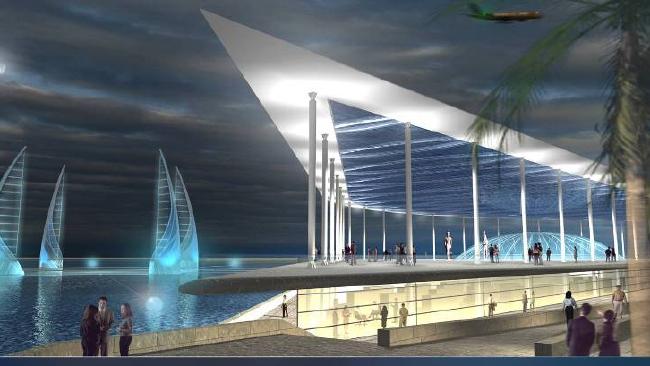
An underwater museum is planned to be built in Alexandria.
Photo: news.com.au
Back in September, the Egyptian Minister of Antiquities, Mamdouh al-Damaty, announced that the government has revived its plans to construct an underwater antiquities museum in Alexandria. Now, authorities have started to develop the museum, which has been estimated to cost in excess of $150 million.
Plans for the project were first floated in October 2008 by then-secretary-general of the Supreme Council of Antiquities, archeologist Zahi Hawass.
Subsequently, a UNESCO feasibility study was launched in May 2010 but was abruptly interrupted by the Arab Spring and the January 25 Revolution that broke out in 2011.
The museum design above ground.
Photo: news.com.au
Two years after the Egyptian revolution, in September 2013, UNESCO and Egyptian authorities rekindled the project once again, and a group of specialists and archaeologists selected the Mediterranean city of Alexandria as a location because of its priceless underwater treasures and relics.
Founded in 331 BC by Alexander the Great, the Alexandria bay holds such sunken treasures as Cleopatra’s Royal Court and the Lighthouse of Alexandria, which is one of the Seven Wonders of the World.
“The museum will reshape the Arab region, as it will be the first of its kind in the world. Undoubtedly it will revive tourism and boost the Egyptian economy after a long recession,” Youssef Khalifa, chairman of the Central Administration of Lower Egypt Antiquities, told Al Monitor.
A graphic showing the museum’s underwater tunnels.
Photo: news.com.au
He added that the museum, designed by French architect Jacques Rougerie, “Will include four tall underwater buildings in the form of Nile boats connected to one another over an area of 22,000 square meters (5.4 acres). They will be lined up in a circle with a radius of 40 meters (131 feet).” The museum will have the capacity to accommodate 3 million visitors a year.
Although funding deficits have recently stifled the construction of Giza’s $1.1 billion Grand Egyptian Museum, the Ministry of Antiquities dismissed concerns over funding for the ambitious underwater project.
“Despite the huge cost of the project estimated at more than $150 million, this will not be an obstacle for the completion of the project with the cooperation of UNESCO and other foreign funding countries as the museum will be open to visitors from around the world and not only to Egyptians,” said the Ministry’s General Director of Sunken Antiquities, Mohammed Mustafa.
The bay of Alexandria, Egypt, the proposed location of the museum.
Photo: news.com.au
However, according to News.com.au the Egyptian Mediterranean is extremely polluted. A report by UNESCO said, “The bay hosting Alexandria’s underwater heritage is heavily polluted. This not only clouds the water, making it difficult to view the artifacts, but also accelerates their erosion.”
A reader of the Al Monitor article asked in a comment “Exactly what tourists want to […] go and watch untreated Egyptian sewage pouring into the Mediterranean?”
Hopefully, plans for the construction of the museum also include a filtering system.